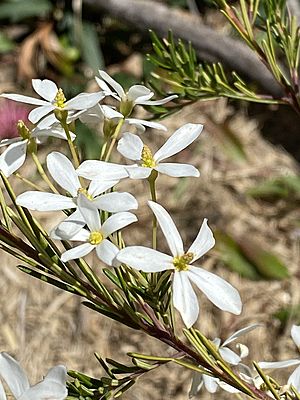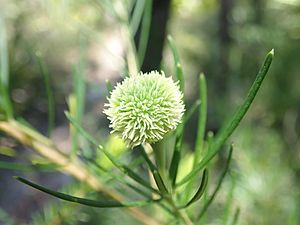Wedding bush facts for kids
Quick facts for kids Wedding bush |
|
|---|---|
 |
|
| Ricinocarpos pinifolius flowers | |
 |
|
| Ricinocarpos pinifolius fruit | |
| Scientific classification | |
| Genus: |
Ricinocarpos
|
| Species: |
pinifolius
|
The Ricinocarpos pinifolius, often called wedding bush, is a type of shrub. It belongs to the Euphorbiaceae plant family. This plant grows naturally only in eastern Australia. In spring, it produces lovely, sweet-smelling flowers that look a bit like daisies.
Contents
What Does the Wedding Bush Look Like?
The wedding bush is a small plant. It usually grows to be about 1 to 3 meters (3 to 10 feet) tall. It can also spread out about 1 to 2 meters (3 to 6 feet) wide. Its branches are smooth to the touch.
Leaves and Flowers
The leaves of the wedding bush are long and thin. They are usually 1 to 3 millimeters wide and 1 to 4 centimeters long. The edges of the leaves might curl downwards or backwards. Each leaf has a small stem, called a petiole, which is about 3 millimeters long.
The flowers grow in groups where the leaves meet the stem. Each group usually has 3 to 6 male flowers and 1 female flower. The main stem holding the flowers is about 10 to 20 millimeters long. The sepals, which are like small leaves protecting the flower bud, are 3 to 4 millimeters long. The petals are usually white and shaped like an egg, about 10 to 15 millimeters long. The parts that hold pollen, called stamens, are yellow.
Fruit and Seeds
After the flowers bloom, the plant produces a seed capsule. This capsule is round, about 12 millimeters across. It is covered with many thick spines, almost like a tiny spiky ball.
How the Wedding Bush Got Its Name
The scientific name for the wedding bush is Ricinocarpos pinifolius. A scientist named René Louiche Desfontaines first described this plant in 1817. He published his description in a book called Memoires du Museum d'Histoire Naturelle.
The second part of its scientific name, pinifolius, comes from two Latin words. "Pinus" means "pine," and "folium" means "leaf." So, pinifolius means "pine-leaved," because its leaves look a bit like pine needles.
Where the Wedding Bush Grows
You can find the wedding bush mostly along the coast of eastern Australia. It grows in sandy soils. It likes to live in areas called "heath" (which are open areas with low-growing shrubs) and in open forests. You can see it in New South Wales, Queensland, Victoria, Tasmania, and the Northern Territory.

